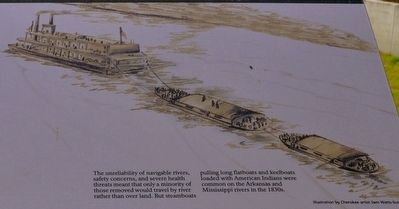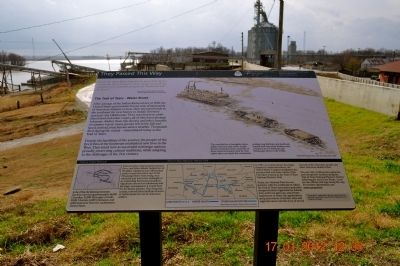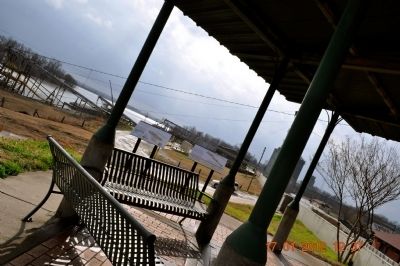Helena in Phillips County, Arkansas — The American South (West South Central)
They Passed This Way
The Trail of Tears - Water Route
—Sin-e-cha's Song, heard on several removal boats along the Trail of Tears.
After passage of the Indian Removal Act of 1830, the United States government forced tens of thousands of American Indians to leave their ancestral lands in the southeast for new homes in Indian Territory (present-day Oklahoma). They traveled over established land and water routes, all of which led through Arkansas. Rather than risk disease and other hazards of summer travel, many groups left in the fall and faced, instead, treacherous winter weather. Thousands died during the ordeal—remembered today as the Trail of Tears.
Despite the hardships of the journey, the people of the five tribes of the Southeast established new lives in the West. They stand now as successful sovereign nations, proudly preserving cultural traditions, while adapting to the challenges of the 21st century.
(Lower level of marker)
Federal Indian Removal
In the 1830s, the federal government forcibly removed approximately 16,000 Cherokee, 21,000 Muscogee (Creek), 9,000 Choctaw, 6,000 Chickasaw, and 4,000 Seminole from the southeastern United States.
Federal Indian removal policy aroused fierce and bitter debate. Supporters of the policy claimed it was a benevolent action to save the tribes east of the Mississippi River from being overwhelmed and lost in the onslaught of an expanding American population. Opponents decried its inhumanity and the tragic consequences it would have for the Indian peoples. One thing was certain; removal freed millions of acres of Indian lands for use by American settlers.
In 1987, to commemorate this tragic chapter in American history, the United States Congress designated the primary land and water routes of the Cherokee removal as the Trail of Tears National Historic Trail.
Today, the National Park Service partners with the southeastern tribes; the Trail of Tears Association and other non-government organizations; federal, state, and local agencies; and private landowners to foster the appreciation and preservation of historic sites and segments and to tell the story of forced removal of the Cherokee people and other American Indian tribes.
You can visit certified sites, segments, and interpretive facilities along the Trail of Tears National Historic Trail by following the Auto Tour route. Look for the official logo along the way. For further information, see: www.nps.gov/trte.
Erected by Arkansas Humanities

Photographed By Sandra Hughes, January 17, 2012
2. They Passed This Way Marker
The unreliability of navigable rivers, safety concerns, and severe health threats meant that only a minority of those removed would travel by river rather than over land. But steamboats pulling long flatboats and keelboats loaded with American Indians were common on the Arkansas and Mississippi rivers in 1830s.
Illustration by Cherokee artist Sam Watts-Scott 2005
Topics and series. This historical marker is listed in these topic lists: Native Americans • Waterways & Vessels. In addition, it is included in the Trail of Tears series list. A significant historical year for this entry is 1830.
Location. 34° 31.342′ N, 90° 35.123′ W. Marker is in Helena, Arkansas, in Phillips County. Marker is on Missouri St.. Marker is under the pavilion at Levee Walk, below are train tracks and the Train Depot. Touch for map. Marker is in this post office area: Helena AR 72342, United States of America. Touch for directions.
Other nearby markers. At least 8 other markers are within walking distance of this marker. Helena and The Trail of Tears (here, next to this marker); The Battle of Helena (a few steps from this marker); Phillips County Goes to War (within shouting distance of this marker); A Union Stronghold in Confederate Arkansas (within shouting distance of this marker); A Great Upheaval (within shouting distance of this marker); Hernando De Soto (within shouting distance of this marker); KFFA 1360 Helena (about 400 feet away, measured in a direct line); The Blues Trail: Mississippi to Helena (about 500 feet away). Touch for a list and map of all markers in Helena.
Credits. This page was last revised on August 9, 2023. It was originally submitted on January 28, 2012, by Sandra Hughes Tidwell of Killen, Alabama, USA. This page has been viewed 815 times since then and 11 times this year. Last updated on July 26, 2023, by Carl Gordon Moore Jr. of North East, Maryland. Photos: 1, 2, 3, 4. submitted on January 28, 2012, by Sandra Hughes Tidwell of Killen, Alabama, USA. • Bernard Fisher was the editor who published this page.


